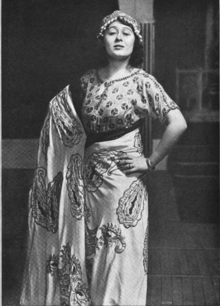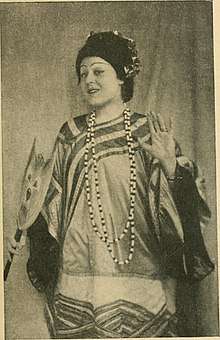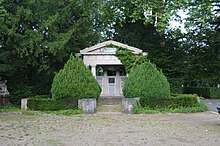Camilla Eibenschütz
Camilla Eibenschütz (July 20, 1884 – July 12, 1958) was a German stage actress.


Early life
Camille Eibenschütz was from Bavaria,[1] the daughter of pianist and music professor Albert Eibenschütz and Anna Theresa Rosa Knorr. Hungarian pianist Ilona Eibenschütz was her father's cousin.
Career
Camilla Eibenschütz was the first actress to play "Wendla" in Frank Wedekind's controversial Frühlings Erwachen (Spring Awakening) in Berlin in 1906.[2] In 1907 she played Juliet in Max Reinhardt's Romeo and Juliet, opposite Alexander Moissi.[3] She also played Ophelia, Viola, and Titania in Reinhardt's Shakespeare productions.[4] Albert von Keller painted her as Myrrhine in Lysistrata in 1909. On Broadway, she starred in Reinhardt's pantomime Sumurun in 1912,[5] with Leopoldine Konstantin, Emil Lind, and other European actors.[6] She was in Blue Bird in Berlin in 1912,[7] and in The Yellow Jacket in Berlin in 1914.[8]
Eibenschütz was known as a collector of art, to decorate her two residences, a country home at Bogensberglehen and a villa at Dahlem.[9]
Personal life

Camilla Eibenschütz married twice; first, briefly, to Polish dramatist Ryszard Ordynski in 1913,[10] and later to newspaper publisher Dr. Wolfgang Huck (1889–1966). They had a son, Andreas Michael Huck (born 1919). She died in 1958, aged 75 years. Her grave is in Offenbach am Main, with other members of the Huck family.
References
- "Camilla Eibenschutz" Pittsburgh Press (March 21, 1926): 98. via Newspapers.com

- Edward Braun, The Director & The Stage: From Naturalism to Grotowski (A&C Black 1986). ISBN 978-1-4081-4924-9
- E. F. S., "The Stage from the Stalls" The Sketch (February 20, 1907): 172.
- "About People" Woman's Home Companion (April 1912): 20.
- "To Produce 'Sumurun' Here" New York Times (December 17, 1911): C4. via ProQuest
- "Sumurun" Theatre Magazine (February 1912): 54–55.
- "'Blue Bird' Given in Berlin" New York Times (December 29, 1912): 27. via ProQuest
- J. O. L., "The Three Arts" Evening Sun (April 17, 1914): 6. via Newspapers.com

- "Catalogue Note: The Huck-Eibenschütz Collection" European Furniture and Good Decorations (Sotheby's 2005).
- "Host of Tourists Invading Berlin" New York Times (August 17, 1913): 2. via ProQuest
External links
- A photograph of Camille Eibenschütz in the Billy Rose Theatre Collection, Photograph File, New York Public Library Digital Collections.
- Camilla Eibenschütz listing at IBDB.
- Camilla Eibenschutz listing at Billion Graves.